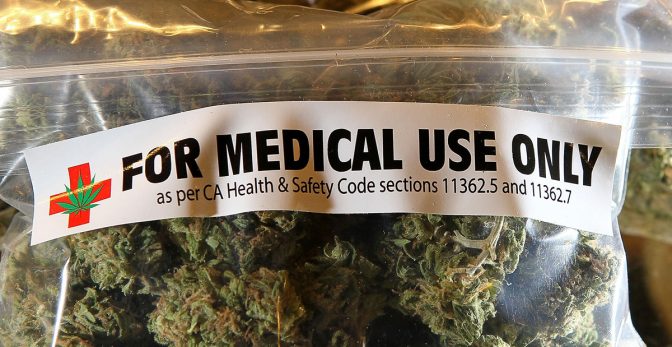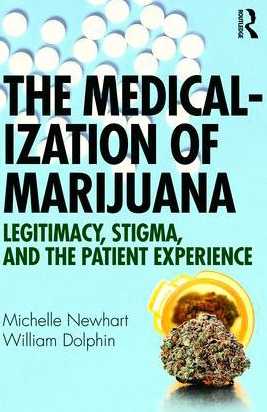Medical Marijuana and Patients: It’s All About the Stigma

In these days of the Green Rush and the apparently inevitable legalization of cannabis, it’s important to bear one thing in mind: marijuana is a real medicine for many people. That’s made clear in The Medicalization of Marijuana: Legitimacy, Stigma and the Patient Experience.
This is not yet another rehash of published medical and scientific literature. It’s a fascinating look at how marijuana’s medical use is perceived by society and how those perceptions have evolved since the first medical program began after the passage of California’s Prop 215 in 1996.
 The book starts by discussing the development of anti-marijuana propaganda, rooted in early 20th Century racist and classist anti-opium campaigns. U.S. marijuana policy went from “indifference to moral panic” in the first half of the 20th century thanks largely to Hearst newspapers’ “yellow journalism” and Harry J. Anslinger, who headed the Federal Bureau of Narcotics. Cannabis may have been medicine and hemp was rope, but marijuana became the “killer weed.”
The book starts by discussing the development of anti-marijuana propaganda, rooted in early 20th Century racist and classist anti-opium campaigns. U.S. marijuana policy went from “indifference to moral panic” in the first half of the 20th century thanks largely to Hearst newspapers’ “yellow journalism” and Harry J. Anslinger, who headed the Federal Bureau of Narcotics. Cannabis may have been medicine and hemp was rope, but marijuana became the “killer weed.”
From killer weed to dropout drug to Just Say No and beyond, authors Michelle Newhart and William Dolphin trace the stereotypes used to stigmatize and marginalize people who consume marijuana. These stereotypes are so deeply ingrained that even people with serious illnesses who could definitely benefit from this alternative medicine, and who live in states where it’s legal, still resist trying it.
Forty Colorado patients were interviewed for the book. The interviewees had a wide variety of qualifying conditions for their medical use, and their individual perceptions about marijuana and marijuana users differed, yet they had a lot in common. For one thing, they’re all middle-aged.
From killer weed to dropout drug to Just Say No and beyond, authors Michelle Newhart and William Dolphin trace the stereotypes used to stigmatize and marginalize people who use marijuana
“Midlife was of interest because that’s the largest growing population who signs up for medical cannabis patient programs, and the patterns of the majority were what you might expect,” Newhart tells Freedom Leaf. «Many had tried it in adolescence and then as they took on more adult responsibilities, had kids, got more serious jobs and so forth, and moved into midlife. It had been a number of years since they’d used cannabis. It kind of fell along the wayside somewhere in there and then they tried it again through a medical lens in midlife. That was a common trajectory that we saw.
“But there was also a minorities who’d never tried it or had tried it in adolescence, liked it a lot and continued to use it throughout adult life on and off, or fairly consistently across adult life. We saw all three of those patterns, but by far the most common one was trying it in adolescence, maybe using it for some time during adolescence, desisting use over adult life and then deciding to try it again medically in midlife… Once they did embark on using it medically, one of the things that’s super interesting was the degree to which it matches the way folks use other medications. It matches up pretty darned well.”
Dealing with the Stigma
The decision to become a medical-marijuana patient was not an easy one for most of the book’s patients. The biggest obstacle is the stigma attached to marijuana use. As the authors note, “The degree to which stigmas of recreational use have been internalized—either as they applied to oneself or, if one was never a social cannabis consumer, to others prior to medical use—can be factors in how well one manages the medical cannabis patient identity.”
Stigma is not only related to marijuana use. There’s also a lot of stigma attached to the label “patient.” The Americans with Disabilities Act only exists because of the long history of discrimination against people who are not fully abled. That’s also a reason why there are privacy laws in regard to health care. The privacy of medical marijuana patients isn’t so well protected, however. Many state programs require patients to register, providing the state with their diagnosis as well as other personal data.
It’s hard to overcome stigma, but people are managing. Much of the book covers how people are changing stereotypes and dealing with the prejudice that still exists. It’s all part of the process of normalizing medical marijuana for the individual patient as well as for broader society. This allows people to more easily integrate the medicine they need into their daily lives.
Simply put, The Medicalization of Marijuana is a great addition to the bookshelf for anyone who’s interested in medical cannabis.
More Book Reviews
Grassroots: The Rise and Fall and Rise of Marijuana in America
Cannabis: A Beginner’s Guide to Growing Cannabis
Brave New Weed: Adventures in the Uncharted World of Cannabis
If you enjoyed this Freedom Leaf article, subscribe to the magazine here

